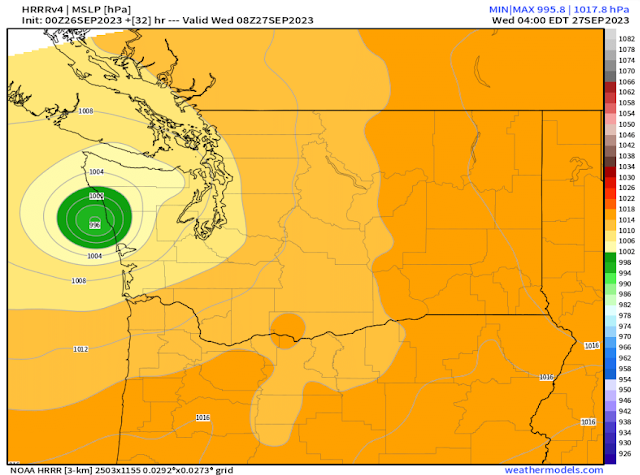FastCast--Friday, Sep. 29 to Tuesday, Oct. 3:
After most of Western Washington received triple September's average rainfall in under one week, conditions will calm down to end the month and begin October. On Friday, Saturday, and Sunday, expect partly cloudy to mostly sunny conditions (sunniest on the weekend), with lowland highs in the low to mid 60s and lows in the mid 40s, except in the low 40s in some outlying areas. Clouds and showers will return on Monday, with a chance of showers (likely 0.1-0.3") and highs dipping to the upper 50s, with lows in the upper 40s. Mostly cloudy conditions look to persist on Tuesday, with highs in the upper 50s to low 60s, and lows in the upper 40s to low 50s. Scroll to the bottom of the blog to see rain amounts for the past few days (spoiler: they're impressive!).
------------------------------------------------------------
Continue reading the full blog below!
After a very rainy and stormy stretch, much calmer weather is in store to end September and begin October. Let's take a look at the forecast!
We'll start below with the European model's forecast for highs on Friday.
On Friday, expect a cool day, with highs across the state in the upper 50s to low 60s, except along the Strait of Juan de Fuca, where highs will remain in the mid 50s. Mountain towns will remain in the low to mid 50s, and the Willamette Valley will reach the low to mid 60s.
Next, let's take a look at Saturday's highs, seen below, also from the European model.
On Saturday, temperatures will climb a bit, with lowland highs in the upper 50s to low 60s, Willamette Valley highs in the mid to upper 60s, and Eastern Washington reaching the upper 50s (near Spokane) to low 70s (in the Columbia Basin). The coast will remain in the upper 50s.
Next, the highs for Sunday, seen below from the European model.
We'll likely warm up more on Sunday. Lowland highs are expected to reach the low to mid 60s, with the Willamette Valley reaching the upper 60s to low 70s, Eastern Washington reaching the mid 60s to mid 70s, and the coast increasing a bit to the upper 50s to low 60s.
What about morning lows? Sunday will likely be the coolest morning of the next few. Below are Sunday morning's lows from the European model.
Expect a chilly morning on Sunday. The lowlands will likely dip to the low to mid 40s, with the Willamette Valley and Eastern Washington dipping to similar low temperatures. The coast and areas near the water will drop to the mid 40s to low 50s. In mountain towns and mountain valleys & foothills, temperatures will likely drop to the upper 30s to low 40s...a sure sign of fall!
Let's end by taking a look at how much rain the region received since Saturday, September 23rd!
A few things to notice here...the lowlands received 1.4-3.5 inches on average, with some areas getting even more. September's monthly average is 1.61" in Seattle, to put it in perspective. The Olympic Mountains were the regional winners, with some stations getting up to 9" of rain! Also, notice the very obvious rain shadow NE of the Olympics. While the southern slopes get 4-8", the northern Olympic Peninsula, San Juans, and Island County got a meager 0.05-0.75", showing the extraordinary rain differences over a small area!
Areas with active wildfires in the Olympics and Cascades received 2.5-6" of rain, effectively ending stopping wildfire season in its tracks!
Enjoy the calm & relatively seasonable weather ahead!



















































